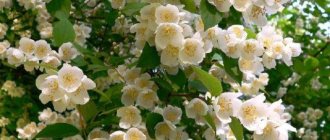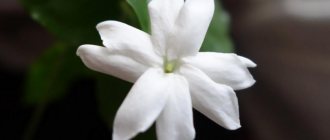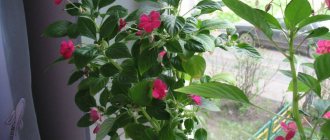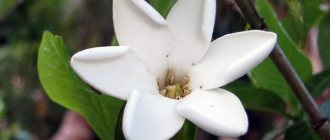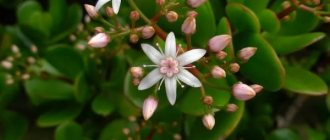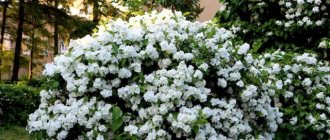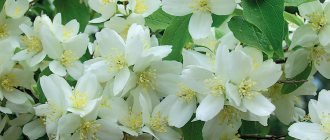What year does jasmine bloom and how long does the flowering period last?
Before you worry about how the plant is doing, you need to know what year after planting jasmine blooms. Depending on the variety, you will have to wait from 2 to 4 years.
Jasmine is easy to care for, but to see the splendor of its inflorescences, you will have to make some effort
Differences in the flowering of garden and indoor jasmine
The difference between jasmine that grows in the garden and one that is in a pot in the house is the timing of the release of buds. The plant stays dormant indoors during the winter. The first buds appear around March-April and last until early autumn.
For most outdoor varieties, the active period begins in June and lasts until the first night frosts.
Additional Information! The winter type of jasmine blooms in January-April. Jasmine sambac with white double petals or polyanthus, when creating comfortable conditions, will delight with beautiful and lush inflorescences throughout the year.
Features of planting
In order for mock orange to bloom magnificently and for a long time in the garden, it is important to plant it correctly. To do this, you need to choose the right place, prepare the soil, and also plant it correctly in open ground.
Mock orange will bloom for 50 years if it is watered in a timely manner, the soil is plowed, fertilized, mulched, branches are pruned, and protected from pests.
Deciding on a landing site
Stagnant moisture and saline soils with groundwater negatively affect mock orange. Therefore, it is recommended to plant the plant on fertile and moist soil. This is the kind of place that will help the mock orange develop and bloom. There are also plant species that can grow in soil with unfavorable environmental conditions.
Jasmines can bloom even in the most shaded places. But they bloom best in partial shade. To admire the flowers of the plant every year, it is recommended to plant mock orange in sunny areas.
Preparing the ground
The soil for mock orange should be fertile and well permeable. It is recommended to cover clayey areas with a drainage layer: sand, broken brick or expanded clay. Sandy areas can be further diluted with compost or vermicompost. The pits for mock orange are filled with a peat mixture with humus, sand and tree leaves. Immediately before planting, it is recommended to add mature humus to the soil. A little fresh manure can be added to the soil in the fall.
Heavy soil can be lightened by adding weathered peat.
Features of planting mock orange
It is recommended to plant young plants as follows:
- Two-year-old seedlings are considered the best planting material.
- If you plan to plant plants in groups, the distance between them should be 1.5 - 2 meters. If a single-row jasmine hedge is planned, seedlings are planted every half meter.
- When planting, the root collar can be deepened a couple of centimeters into the soil. If it is placed more than three centimeters deeper, the plant will rot.
- The size of the planting holes should be more than 40x40x40 centimeters.
- In order for valuable mock orange varieties to take root better, they can be fertilized with Zircon or HB-101.
- Before planting seedlings in open ground, remove broken and dried branches and roots. Distribute the roots evenly in the center of each hole. Cover with moist, nutritious soil and water well. Every bush needs a bucket of water. It is recommended to water the bushes every three days for 14 days after planting. Then the bushes are watered as needed.
Reasons for the lack of flowering in garden and indoor jasmine
Why hydrangea does not bloom - what to do if a garden flower produces only foliage
Knowing how many years it takes for jasmine to bloom, some gardeners note that time passes, but the buds never appear. In such a situation, you need to reconsider the care of the plant.
Lush leaves and lack of buds are a common problem.
Stagnation of moisture or lack of it
The plant loves moderate watering. Its excess leads to rotting of the roots, which is why the bush gradually fades.
When placing a shrub on a site, you need to choose the right place for it. It is prohibited to place the plant in places where groundwater passes close to the ground and in lowlands where water accumulates. Watering rules:
- regular and abundant;
- It is forbidden to use cold water and from the tap;
- watering is carried out with filtered or purified, settled water;
- It is recommended to add a few drops of acetic or citric acid to the water to acidify the liquid;
- if jasmine grows in a pot, the container should have drainage and holes in the bottom to allow residual water to escape.
Additional Information! The top layer of soil should dry out between waterings. Stagnation of water is also detrimental to home jasmine.
Insufficiently acidic soil
Jasmine should only be planted in acidic soil. If the soil is alkaline, jasmine buds will never appear.
Diseases and pests
One of the factors why garden jasmine does not bloom is its damage by insect pests or diseases. Pests:
- Aphids are large, green, and settle on the tops.
- The weevil settles in the soil near the plant and feeds on the sap of leaf blades.
- Spider mite - leaves are dotted with numerous dots, cobwebs are visible.
Diseases are indicated by yellowed or curled leaves, wilting of the entire bush, lack of growth, and falling leaves.
Diseases of the plant often lead to a slowdown in its development
Errors when applying fertilizers
The plant stops producing buds if it receives large quantities of nitrogen fertilizers. They promote the active growth of shoots and leaves, which is why the bush does not have the strength to form inflorescences. Recommended feeding mixture:
- urea 15 g;
- superphosphate 30 g;
- potassium sulfate 15 g;
- water 10 l.
Fertilizers must be alternated using mineral and organic substances.
Inappropriate lighting
If indoor jasmine does not bloom, what should I do? First of all, you need to check where the flowerpot is placed. Despite the fact that this plant is a light-loving plant, the lighting should be plentiful, but diffused, without direct sunlight. The sun causes the leaves to burn and fall off.
Additional Information! It is recommended to place the jasmine pot on the windowsills on the west or east side. On the north side it will not have enough lighting.
Temperature changes
Low temperatures at night and high temperatures during the day have a detrimental effect on the plant. It is easiest to eliminate this factor for jasmine that grows indoors. The optimal temperature is from +18 to +22.
No trimming
If the shoots are not trimmed in a timely manner, the bush will spend all its energy on their growth. Jasmine should be no more than 2 m long. If the height is 3 m or more, there will be no buds. Pruning should be regular, following a number of recommendations:
- Autumn - carried out after all the buds have withered. You need to trim off all dried inflorescences, bad and weak shoots. The cut areas should be treated with garden decoction.
- Spring – until early April. Those shoots that did not survive the winter well, old branches, and leaves left over from last year must be removed.
- Rejuvenating – carried out every 3 years. Old branches are completely cut off.
After pruning, the bush should be watered abundantly.
One of the mandatory measures is regular pruning.
Plant age
A bush that is too young and under 3 years old will not produce buds. All his strength goes into growth and strengthening.
Diseases
Another reason why mock orange does not grow and does not produce flowers is various diseases. Most often they occur due to improper care, damage by fungi and viruses. It is not difficult to detect the presence of a disease if you carefully examine the plant. Often the first symptoms are visible immediately, as the leaves and shoots are the first to be affected. Initially, yellow spots appear, the foliage curls and dries out.
It is recommended to treat with fungicides or other antifungal agents. It is important to carefully inspect the areas of all jasmine, as damage to the lower shoots or roots is possible.
To avoid the occurrence of diseases, you must adhere to the following rules:
- Be sure to use drainage to avoid water stagnation.
- Grow the indoor plant in a container of suitable size.
- In winter, send the flower to rest.
- Prune annually.
- Monitor watering. Jasmine begins to shed its leaves if the soil is too wet or, conversely, dry.
- Provide normal humidity. Shoots dry out when humidity is low and the soil is completely dry.
- Use the right water. When using alkaline water, the twigs begin to dry out.
The presence of any problem will negatively affect the flowering of jasmine.
The absence of flowers in mock orange may indicate a lack of light. And if the buds have darkened, it means the air around is too dry and warm.
Gray rot on mock orange leaves
Other Possible Flowering Problems
In addition to the lack of buds, the gardener may encounter such phenomena as their too small size or their premature shedding.
Shedding of buds
How to propagate garden jasmine in spring and summer
Jasmine can drop buds prematurely under the influence of the following factors:
- Draft or strong wind.
- Use for cold water irrigation.
- Untimely and incorrect transplantation, when the plant has already begun to produce buds.
- Dry soil, lack of nutrients and minerals.
- Incorrectly selected fertilizer or its use in excessive quantities, which causes the roots to burn.
- Lack of lighting.
Jasmine may drop its buds because the room is too hot or exposed to direct sunlight.
Additional Information! It is recommended to plant jasmine outdoors in partial shade or in a place where the lighting is good but diffuse. It is especially necessary to follow this recommendation when planting a plant in the Moscow region, where summers can be very hot.
Small flowers
Varieties of mock orange with large inflorescences include:
- Mont Blanc;
- Pyramid;
- Schneeshturm;
- Zoya Kosmodemyanskaya;
- Virgin;
- Coronary.
Owners of jasmine with large inflorescences may encounter a problem such as insufficient bud size. This is due to improper care of the plant:
- frequent drying out of the soil;
- absence or insufficient pruning, due to which the plant puts all its energy into the growth of new shoots;
- insufficient refills or their incorrect choice;
- unfavorable location of the plant in the country - the influence of a draft or strong wind, stagnation of moisture.
Establishing care will help normalize the condition. If the plant is in a draft or exposed to direct sunlight, replanting will be required.
Attention! Transplantation is prohibited during the period when jasmine is actively putting out new buds.
Home care
Indoor jasmine can hardly be called an unpretentious crop. To grow a beautifully flowering and fragrant shrub, you need to provide it with proper home care . Therefore, every rule for caring for it must be strictly followed.
Humidity and watering
In the summer, jasmine needs high-quality and very abundant watering. The substrate must not be allowed to dry out completely. Enough for the top layer of soil to dry out. It is the control of soil dryness or moisture that will allow you to create a stable watering regime for jasmine.
In winter and autumn, you need to water the plant very carefully, especially if the room temperature is low. Under no circumstances should the soil be over-moistened . Its weak dryness at this time is the key to the future lush flowering of the crop.
The watering schedule, as with other indoor flowers, requires seasonality.
Even if the apartment is warm, the plant needs to be watered less in any case. In this case, you should wait until the top and middle layers of the substrate dry out in order to maintain the humidity level.
It is recommended to reduce watering gradually without sudden actions. This must be done for at least a month.
Water is also of great importance. Firstly, soft water is required, and it also needs to be settled for several days before watering. And, secondly, the water should be slightly warm.
In addition, it is recommended to use filtered, boiled water . To compensate for the salt in the water, periodically water the bush with water and lemon juice. You can also replace it with citric acid.
One of the most difficult rules in caring for crops is maintaining high air humidity. Dryness results in poor development and lack of flowering and exposes the plant to pests and disease, causing it to die.
At the flowering stage, spraying is also desirable, but care must be taken to ensure that the liquid does not get on the flowers .
The use of humidifiers is also important. It is advisable to put moss or moistened pebbles in the tray.
If the crop is grown at cool temperatures in winter, then no measures to increase humidity are required. If the room is warm, then all the same procedures are done as in the summer.
Temperature and light conditions
In summer, the temperature should be about 23 degrees. Jasmine can easily tolerate high temperatures.
Protect jasmine from direct sunlight - burns are dangerous
In winter, only sambac (a type of jasmine) needs high temperatures of about 18-20 degrees; a decrease in temperature will affect the flowering of this species. Other varieties, on the contrary, will bloom more profusely if the air temperature is within 10 degrees.
The culture prefers good lighting. Not only flowering, but also leaf opening depends on this. At the same time, it does not tolerate direct rays of the sun, and therefore jasmine should not be placed on southern windows. The best choice would be eastern and western window sills . Artificial lighting is not suitable, as are shaded locations.
During the resting stage, there is no need to adjust the lighting. At the same time, some species even shed their leaves, so they do not need to increase or decrease the light level.
Soil and fertilizers
The substrate for the culture requires neutral or slightly acidic. It should be of high quality, loose and enriched with nutrients. Ready-made universal primers are suitable.
When preparing the soil yourself, it is difficult to make a mistake in the proportions - all components are present in equal parts
What to do if jasmine does not bloom on your property or at home
Indoor jasmine - how to care
The absence of buds in a plant over 3 years old is a signal to the gardener that he is not caring for it correctly. To restore the condition of jasmine, it is necessary to carry out a number of measures to eliminate negative factors:
- normalize watering - it should be frequent, but without overwatering;
- change, if necessary, the location - diffused light or partial shade is needed;
- change fertilizers. If only nitrogen substances were introduced, it is necessary to alternately use mineral and organic feeds;
- normalize cropping. It should be regular, held in autumn and spring.
If the jasmine is on the street and all measures to resuscitate it have been in vain, it needs to be transplanted. Perhaps it's all about the soil being poor in nutrients and minerals.
Jasmine will thank you for comfort with delicate, beautiful petals.
Types of jasmine: multifloral, sambac, holoflorous
Among the most common and most interesting types are:
- Sambac is the most unpretentious variety and tolerates warm winters well. Its shoots grow up to 6 meters. White, fairly large flowers with a pronounced aroma are collected in racemes. Blooms from early spring to mid-autumn;
The remarkable thing about the Sambac variety is its unpretentiousness, compared to other varieties of jasmine.
- Multi-flowered jasmine is characterized by strong branching. Can reach a height of about 2 meters. The buds are pink in color, and the flowers are white after blooming. It has the strongest aroma among other varieties. It begins to bloom at the end of winter and ends in August;
- Holofloral jasmine branches weakly, and there are few leaves on the shoots. In winter, the leaves fall off completely or partially. The flowers are bright yellow and reach a diameter of about 3 cm. Blooms from January to April .
How to care for jasmine after the flowering period
During the dormant period, caring for jasmine includes:
- reducing the frequency and amount of fertilizers applied using organic matter;
- reducing watering, but without prolonged drying out of the soil;
- pruning;
- preparation for wintering.
Pruning at the end of the active period involves removing faded buds and bad, weakest shoots.
Most varieties of jasmine are frost-resistant. But in regions with severe frosts, it is necessary to build a shelter for the plant, covering it with spruce branches or agrofibre. Young shoots under 4 years of age especially need shelter.
Jasmine is a beautiful plant, with a variety of colors of delicate petals, for which it is so loved. But it happens that it cannot bloom and the reason for this is improper care. To normalize the condition of the plant, it is necessary to create comfortable conditions for it outdoors or in a pot.
Varieties
There are more than 300 plant species in the world. We invite you to consider the most common ones. They may differ not only in appearance, but also in care features.
- Jasmine flattened. It is small in size. The leaves are lightish, lanceolate. This species has flowers of a delicate purple hue and a persistent aroma.
- Shrub jasmine. A shrub with flexible and smooth shoots. Grows in height up to 1.5 meters. Leaves are paired. Flowering in the form of half-umbrellas on the sides of the shoots.
- Jasmine Lerata. The adult species reaches 3.5 meters. Its stems have dark green leaves and small white buds with a mint aroma.
- Multi-flowered jasmine. Climbing plant. The leaves are covered with grayish hairs. Star-shaped flowers are collected in inflorescences and are located along the entire length of the shoots. Flowering occurs all year round. Has a pleasant aroma.
- Medicinal jasmine. A weaving plant with long shoots and paired smooth leaves located on them. The flowers are white, fragrant, located on stalks. This species is used for medicinal purposes.
- Jasmine sambac. A climbing species with leathery, oval-shaped leaves and white double flowers that have a very strong aroma. The buds are collected in clusters. Blooms all year round with good care.
- Chinese jasmine. It grows as a vine or shrub with shoots up to 10 meters and has white flowers with a pronounced aroma.
